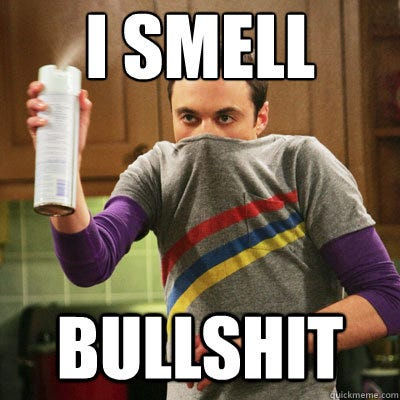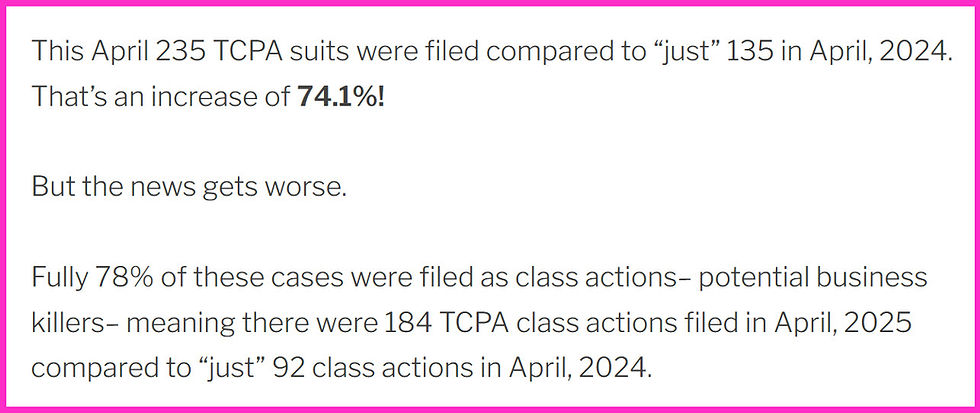TCPA counterclaim immediately fails for lack of facts
- Peter Schneider

- Jun 5
- 4 min read
Updated: Jul 22

Our friend Mr. Troutman started telling telemarketers to reflexively file counterclaims in response to Telephone Consumer Protection Act plaintiffs filing lawsuits. It is intended to intimidate and scare off lawsuits so that telemarketers can get back to doing what they do.
Some of his audience listened, but it didn't work on multiple levels. First, as he reported on this blog, lawsuits in April of 2025 were up 74% year over year.
Second, meritless counterclaims run a high risk of getting dismissed right away, they allow the plaintiff to roughly double the discovery they can propound, they roughly double the litigation costs to the defendant (and the plaintiff too) and they increase the value of the case to the plaintiff because when/if the case goes to trial, you can piss off the jury that the defendant refused to take responsibility.

It's common sense. TCPA plaintiffs should not bring bogus claims and TCPA defendants should not bring bogus counterclaims. Making meritless claims has a tendency to fly back into your face. So it was interesting to see a TCPA defendant file a counterclaim devoid of well plead facts on December 11, 2024, and then voluntarily withdraw it a month later. The case is Julian v. Clearlink Insurance Agency, LLC, case number 2:2024cv02293 filed in U.S. District Court for the District of Kansas.

Fraud claims must be plead with particularity
In the ninth circuit, fraud claims must be plead with particularity. See Davidson v. Sprout Foods 106 F.4th 842, 853 (9th Cir. 2024).
Because all these claims are grounded in fraud, plaintiffs’ First Amended Complaint needed to satisfy not only Rule 12(b)(6)’s plausibility pleading standard but also the heightened pleading requirements of Rule 9(b). See Davidson v. Kimberly-Clark Corp., 889 F.3d 956, 964 (9th Cir. 2018). Rule 9(b) requires that a party plead fraud with particularity. This means the complaint must “identify the who, what, when, where, and how of the misconduct charged, as well as what is false or misleading about the purportedly fraudulent statement, and why it is false.”
Lets review Clearlink's factual allegations and see if it identifies the who, what, when, where, and how of the misconduct charged.
¶9. Julian manufactured TCPA claims here in an attempt to extract a payment from Defendant and its independent vendors. ¶10. Among the services Clearlink offers are health insurance services for consumers who express interest in those services. To communicate effectively with consumers, and avoid litigation for alleged TCPA violations, Defendant and its vendors only call persons who are interested in its services and consent to receive calls about the same. Defendant further requires that its independent marketing vendors comply with the TCPA and only call persons who affirmatively consent to receive calls from Defendant. ¶11. Here, Julian provided express consent for Clearlink’s vendors to call him in order to manufacture TCPA claims. ¶12. Julian subsequently received a phone call from a third party that transferred the call to Clearlink. ¶13. Despite knowing that he gave express consent to receive the Subject Call, Julian proceeded to file a class action lawsuit against the Defendant, alleging that it called him without his consent in purported violation of the TCPA.
These are all conclusory statements. When a TCPA plaintiff comes to court with similar conclusory statements, they get dismissed. See my recent blog post analyzing TCPA lawsuit Lightfoot v. SelectQuote where there isn't a FRCP 9(b) pleading standard. In addition to only making conclusory statements, Clearlink didn't bother answering the questions "When did Julian do this? Where did Julian do this? How did Julian do this?
Julian came back with a motion to dismiss the counterclaim.
Defendant’s bare-bones fraud claim fails to allege the circumstances of the alleged fraud with the particularity required by Rule 9(b). Defendant does not specify the who, what, where, or when of the alleged fraud. Instead, Defendant vaguely asserts that Plaintiff “or someone” consented at some unspecified time, in some unspecified manner, to receive unspecified calls. Moreover, Defendant fails to allege with particularity how it relied on the alleged consent. Without alleging when or how the alleged consent was given, Defendant cannot plausibly allege how or when it was relied upon. Defendant does not even claim that it was aware of the alleged representation before purportedly relying on it. The only reasonable inference from the facts pleaded in Defendant’s counterclaim is that Defendant relied on its vendors or agents to obtain consent before making calls. There are no allegations in the counterclaim to support the inference that Defendant relied on any alleged statement by Plaintiff or “someone acting on his behalf.”
Empty headed counterclaims are obnoxious, but they are also an opportunity. If you get one it would be good to consult with a TCPA attorney to help you exploit it.
Do you have a question or a telemarketing, debt collection, or bankruptcy case that would make a great blog article? We might even review your pro-se complaint or motion in a blog post. Email peter@nwdebtresolution.com and/or nathen@nwdebtresolution.com and we may answer it for everyone!
Are telemarketers harassing you in Washington, Oregon, or Montana? My Washington State TCPA plaintiff law practice can help, just give us a call at 206-800-6000 or email peter@nwdebtresolution.com.
The thoughts, opinions and musings of this blog are those of Peter Schneider, a consumer advocate and Washington State plaintiff's TCPA attorney at Northwest Debt Resolution, LLC. They are just that, his thoughts, opinions and musings and should be treated as such. They are not legal advice. If you are looking to file a lawsuit for TCPA violations and unwanted calls please contact me for a consultation.



Comments